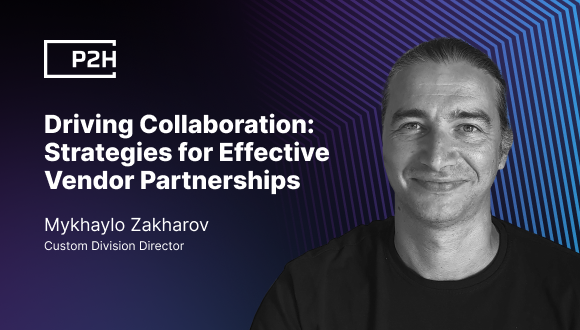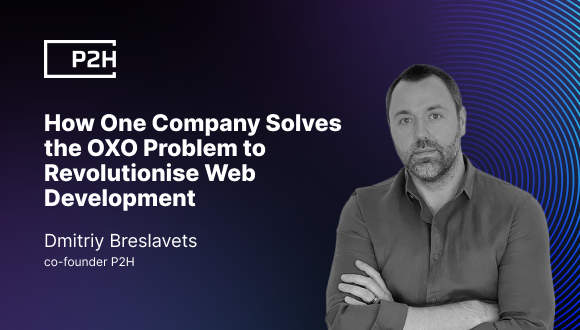
We are constantly looking for new ways to make your interaction with P2H more convenient, smooth, and efficient. This is not simply a search for the optimal approach to managing organizational processes. This is our cornerstone philosophy. P2H has a flat organizational structure. We’ve abandoned the multi-level hierarchical system, delegating more responsibilities to self-organizing clusters where project work is actually performed.
This new approach was a reaction to the rapid evolution of the front-end and back-end development market. Our company has a 14-year history. Over this time, we’ve tried many different labor management systems and came to a conclusion: to catch up with the highly dynamic world of technology, we must change our standard management methods.
In this post, we’d like to tell you about our company’s structure, its working processes, and its practices. We hope this will help you get to know P2H better by seeing what it’s like inside.
1. A Quick Reaction to Changes in the Market and Inside the Company
A flat organizational structure supposes a minimum number of management hierarchy levels. The fewer levels there are, the faster solutions are found. This is important since the present-day world of technology is very dynamic. It’s changing so fast that any delay with a solution can result in missing deadlines.
Let’s take our ASAP service, for example. Repeated requests for ASAP development were like a signal to us: we needed to create a new process. As a result, we quickly formed the ASAP cluster that soon shared its parallel development expertise with the rest of the company’s developers.
The company has an entire system of values and practices that enables us to be synchronized within a common process without needing to have every step approved by the company’s management. This considerably shortens the way from finding a solution to its implementation and allows us to react to our clients’ requests fast.
2. Project Development Work in Cross-Functional Clusters
When interacting with each other inside the company, we are guided by this principle: it makes no sense to hire professionals and then tell them how to do their work. Every day our employees face a large number of various tasks and successfully handle them. What’s the point of telling them how to tackle those tasks? We gave priority to self-organizing, cross-functional teams gathered in clusters.
Every cluster has all the required resources and expertise to solve complex problems. Within a cluster, a development team can be formed to implement a specific project. Our clients can expect their projects to be done by professionals with the appropriate expertise to meet the exact technical requirements. No matter how complex a project is, a cluster possesses all the necessary resources to implement it, as well as all the capabilities to involve more expertise, should the need arise.
3. High Level of Responsibility
One of our values emphasizes the importance of thinking about the big picture while performing tasks individually. What is implied here is a personal responsibility. We understand that it’s not enough to do your part of the job well. You also need to consider how it will fit into the overall process. This is particularly crucial for the clients who hire us as intermediaries in their business flows. They are set on getting a product that will ideally fit into their final jigsaw puzzle with no need to refine or modify it to suit their specific needs. That’s the reason why we always strive to elicit a client’s exact expectations and understand what problem they’re trying to solve.
For this purpose, we have the Engagement Management Cluster. Its main task is to determine a client’s requirements as precisely as possible and suggest the best ways to meet them. This is a whole process that begins with a call, chat message, or analysis of the information provided through the “Order now” form and ends with a completed project.
4. Resources Available on Demand
A flat organizational structure implies well-developed horizontal relationships. A high degree of action coordination helped us allocate our resources more efficiently. Regardless of the complexity of a project we need to implement, we can always find the best combination of methods and expertise for it. This is possible thanks to well-tuned communication both across the company and within each of our clusters.
It’s exactly this smooth process of resource allocation that has become one of our benefits. We constantly review our workflows in order to quickly identify and eliminate the risk of bottlenecks. Thanks to this, our clients don’t have to stand in line. They can count on available resources on demand.
5. Transparent Processes with a Predictable Outcome
We find it important for every client and employee to understand how the company’s processes work. This enables us to constantly improve them. We think that positive changes begin with analyzing processes. When their structure and inner workings are open and understandable for everyone, we can speak about transparency. In a process like this, you can easily discern arising problems. They get solved quickly because the tools that can change the situation are freely accessible.
Process transparency is one of the key indicators in our company. The greater it is, the more favorable are the conditions for obtaining predictable results. When our employees and clients can observe a process at each stage, they have no doubt about its outcome. Our Project Managers are always available for communication and ready to inform you of the status of your project at any given moment. They are in constant touch with clients during all development stages.
6. The flexibility of Processes as a Guarantee of Achieving Predictable Results
We provide our services in a sphere where you may have to deal with a sudden change in priorities, a modification of previously set requirements, or the necessity to create new processes in order to fulfill custom requests. All these circumstances arise due to our clients’ business interests. We can’t ignore them and must be ready to react to changes at any time. In this case, simply providing a range of possible interaction formats is not enough. If all of them fail to satisfy a client’s needs, we must always be able to adjust our process to new requirements.
For example, as soon as we noticed that some of our clients felt comfortable working with the same developers, we immediately adjusted our process to fulfill this request by offering the “Same developers at any time” service. The same goes for ad-hoc interaction, ASAP development, and dedicated hours. All these options were added because we were ready to adjust to our clients’ varying requirements.
7. Favorable Environment for Innovations
A flat organizational structure creates a wide range of opportunities for introducing innovations. In an environment where everyone can obtain resources to implement their initiative, ideas are in abundance. It makes no difference if it’s about creating a new cluster or enhancing a feedback form. Every change like this is a valuable contribution to building quality services that satisfy clients’ needs and can anticipate their expectations.
We are proud that our company has managed to achieve two different business goals: sustainable growth and invariably high quality of services. There are more than 500 of us now. Our offices are located in four countries, and we want to continue growing. This, however, doesn’t prevent us from finding an individual approach to every client.



